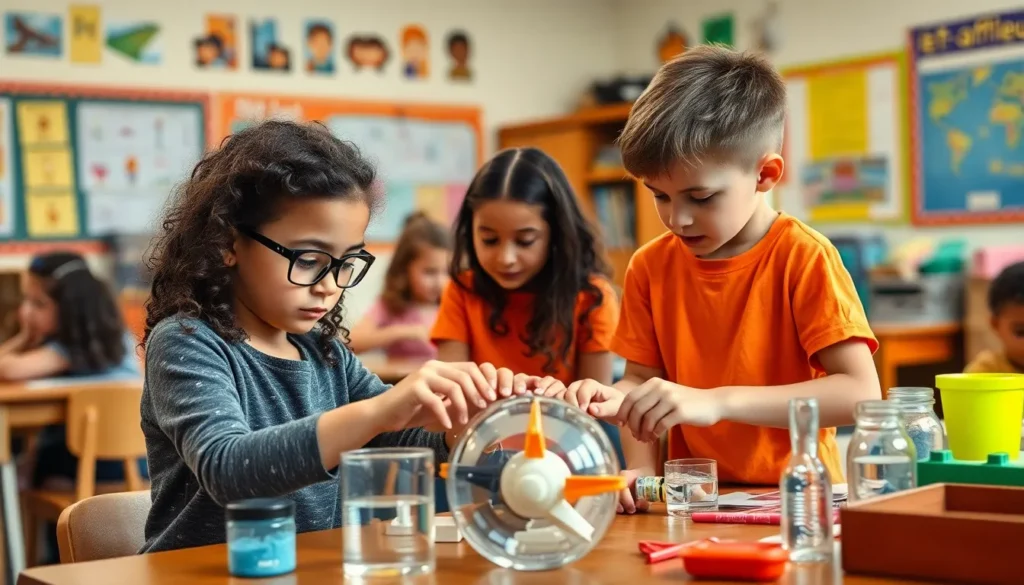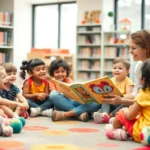Table of Contents
ToggleIn a world buzzing with educational trends, child-focused learning stands out like a bright crayon in a box of dull pencils. This approach isn’t just a passing fad; it’s a game-changer that puts kids at the center of their own learning adventures. Picture this: instead of being lectured at, children are encouraged to explore, question, and create. Who wouldn’t want to trade a boring classroom for a vibrant learning playground?
Overview of Child-Focused Learning
Child-focused learning centers on engaging children as active participants in their education. This approach emphasizes exploration, questioning, and creativity, moving away from traditional lecture-based methods.
Definition and Principles
Child-focused learning encourages children to take control of their educational journey. This educational philosophy prioritizes individualized experiences, fostering curiosity and critical thinking. Key principles include experiential learning, which emphasizes hands-on activities and real-world applications, and collaboration, promoting teamwork among peers. Flexibility in teaching methods supports diverse learning styles, enabling children to engage fully in their lessons. Respect for children’s interests and choices enriches their learning environment, making it more relevant and motivating.
Importance in Education
Educational systems benefit significantly from adopting a child-focused approach. This method enhances student engagement by making learning enjoyable and relevant. Increased motivation leads to improved academic performance as children feel invested in their education. By encouraging independence, this approach fosters essential life skills such as problem-solving and decision-making. Additionally, child-focused learning nurtures emotional well-being, promoting resilience and confidence. Educators who implement child-focused practices create a supportive atmosphere that values each child’s unique contributions.
Benefits of Child-Focused Learning

Child-focused learning offers numerous advantages, significantly enhancing educational experiences for children. This approach fosters a more engaging and personalized atmosphere for learning.
Enhanced Engagement
Incorporating child-centered techniques results in increased student participation. Children actively participate in discussions and hands-on activities, making learning enjoyable. They’re more likely to express curiosity and ask questions in a supportive environment. This method encourages exploration, allowing learners to pursue interests that resonate with them. Teachers who implement this strategy often observe higher levels of motivation and enthusiasm among their students. Engaging children in collaborative projects further strengthens their connection to learning while building social skills.
Improved Learning Outcomes
Child-focused learning correlates with stronger academic performance. Students tend to demonstrate better retention of information through experiential learning. They develop critical thinking skills as they analyze real-world problems and devise solutions. Enhanced independence in learning encourages self-regulation, leading to improved study habits. This educational approach nurtures creativity and innovation, equipping children with essential life skills. Research indicates that learners exposed to this methodology perform better on assessments. Overall, child-focused practices foster an environment where children thrive academically and personally.
Strategies for Implementation
Effective strategies enhance child-focused learning. These approaches create a dynamic atmosphere that promotes engagement and supports diverse learning needs.
Creating a Supportive Environment
A supportive environment cultivates open communication and respect. It involves setting up a classroom that encourages collaboration among students. Teachers can arrange seating in pairs or small groups, fostering interaction. Inclusivity in materials and activities allows children to feel valued. Integrating feedback mechanisms helps students express their thoughts. Utilizing positive reinforcement promotes confidence in their abilities. Decorations reflecting diverse cultures enhance a sense of belonging. This all contributes to an emotionally safe space for exploration and learning.
Encouraging Autonomy and Choice
Children thrive when given autonomy in their learning. Allowing them to choose topics that interest them increases motivation. Teachers can include activities that empower decision-making, such as project-based learning. Students benefit from having options in assignments, enabling personalization of their educational journey. A curriculum designed around choice can facilitate deeper engagement with material. Providing opportunities for self-directed learning nurtures responsibility. Ultimately, these strategies support children’s development of critical thinking skills while fostering a love for learning.
Challenges in Child-Focused Learning
Child-focused learning faces various challenges. These hurdles can impede effective implementation and the achievement of optimal outcomes.
Resistance from Traditional Methods
Resistance from traditional methods proves significant. Many educators trained in conventional teaching approaches struggle to adapt to child-focused strategies. A prioritization of rote memorization often overshadows hands-on learning experiences. Change can intimidate educators who fear it may disrupt classroom management. Concerns arise about the perceived loss of control over lesson pacing and content coverage. As a result, some teachers may revert to familiar practices, limiting the benefits of child-centered education.
Resource Limitations
Resource limitations present another challenge. Schools may lack adequate materials or funding necessary for experiential learning activities. Insufficient access to technology can hinder the implementation of innovative teaching methods. Class sizes may also impede individualized attention and support for each student. Limited professional development opportunities can leave educators feeling unprepared for child-focused strategies. These constraints often create barriers to fully embracing the benefits of this engaging educational philosophy.
Child-focused learning represents a significant shift in educational philosophy that prioritizes the needs and interests of children. By fostering an environment where students can explore and engage actively, this approach not only enhances motivation but also nurtures essential skills for lifelong success.
Implementing child-focused strategies can lead to improved academic performance and emotional well-being. While challenges exist in transitioning from traditional methods, the benefits far outweigh the obstacles. Embracing this transformative approach ensures that education becomes a more personalized and enriching experience for every child. With the right support and resources, educators can create a vibrant learning atmosphere that empowers children to thrive.





